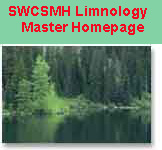Disclaimer & Copyright Notices; Optimized for the MS Internet Explorer
(True water mites)
Soil & Water Conservation Society of Metro Halifax (SWCSMH)
![[water mites.jpg]](../mites.jpg)
Order: Acariformes
Updated: October 09, 2013 
Contents:
- Superphylum Arthropoda
- (jointed-legged metazoan animals [Gr, arthron = joint; pous = foot])
- Phylum Entoma
- Subphylum Chelicerata
- Class Arachnida
- Subclass Acari (mites)
- Order Acariformes
- Suborder Prostigmata (= suborder Trombidiformes, = suborder Actinedida)
- Cohort Parasitengona
- Subcohort Hydrachnidia- (= Hydrachnida, = Hydracarina) (True water mites)
Introduction
The Hydrachnidia are not the only aquatic
mites, but they are the most successful group of mites found in
freshwater. The mites form a considerable part of the lasiophil fauna.
They inhabit almost every aquatic habitat, and densities frequently
exceed 200 mites/sq.metre. Water mites are frequently brightly coloured
and sometimes relatively large (over 2 mm), making them more
conspicuous than other aquatic mites, and thus exaggerating their
already significant predominance. However, there is in fact a tendency
for all the species recorded from the lasion to be small; 49 percent
are under 1 mm long, whereas in the littoral fauna as a whole only 29
percent are as small as this.
Many water mites exhibit bright
colour patterns, containing greens, blues, oranges or reds. Red
predominates among species in the "primitive" Hydrovolzioidea,
Hydrachnoidea, Eylaoidea, and Hydryphantoidea, and often the term the red water mites
is used to denote this ancestral stem. Fish and invertebrates will eat
water mites, but the brightly coloured species are apparently
distasteful and predators learn to reject them.
The Hydrachnidia are among the most
numerically abundant and taxonomically diverse of the freshwater
aquatic mites. Several factors have probably contributed to their
success:
- Their parasitic association with insects greatly increases their dispersal.
- Presumably, when the Chironomidae underwent rapid species radiation, so did the species of mites that parasitized them.
- Mite larvae feed on a
different food source (either a different species or a different life
history stage) from that of the deutonymph and adult. This trait adds
energy from a different resource and minimizes competition between
instars. (An analogous argument has been advanced as one of the factors
contributing to the success of holometabolous insects).
- The resting stages are ideally suited for diapause, and several groups (e.g., Arrenurus planus) use these stages to avoid unfavourable conditions. (Again, an analogous argument has been applied to holometabolous insects).
- The ability to swim,
restricted among mites to species of Hydrachnidia, greatly contributes
to their dispersal and allows for a broader diversity of life styles.
Habitats
Species of Hydrachnidia are common in such
lentic waters as swamps, marshes, ponds, and the littoral and profundal
zones of lakes. They are often associated with vegetation or with the
top few millimetres of substrate, but they can also lead a planktonic
existence. Water mites are common, too, in the erosional and
depositional zones of rivers, and the air-water interface at the
margins of various water bodies harbours a variety of these mites. Some
species are adapted to live in such extreme environments as thermal
springs, glacial meltwater rivers, temporary pools, waterfalls, and in
groundwater buried within gravel banks of streams (interstitial
habitats). A few species can inhabit oceans and inland saline waters,
although most are limited to freshwater.
Water mites in lentic waters are
often free-swimming and conspicuously coloured, but many interesting
species are cryptic, clinging to vegetation or buried in the substrate.
There is also a distinctive fauna deep within gravel beds of lotic
waters. Wet moss and other vegetation in bogs, springs, seepage areas,
and at the margins of various water bodies harbour a characteristic
mite fauna.
Water mites are among the most abundant and
diverse benthic arthropods in many habitats. One square metre of
substratum from littoral weed beds in eutrophic lakes may contain as
many as 2000 deutonymphs and adults representing up to 75 species in 25
or more genera. Comparable samples from an equivalent area of
substratum in rocky riffles of streams often yield over 5000
individuals of more than 50 species in over 30 genera (including both
benthic and hyporheic forms). Mites have coevolved with some of the
dominant insect groups in freshwater ecosystems, especially
nematocerous Diptera, and interact intimately with these insects at all
stages of their life histories.
Species of water mites are
specialized to exploit narrow ranges of physical and chemical regimes,
as well as the particular biologic attributes of the organisms they
parasitize and prey upon. Preliminary studies of physicochemical and
pollution ecology of the relatively well-known fauna of Europe have
demonstrated that water mites are excellent indicators of habitat
quality. The results of these studies, along with observations in
sampling a wide variety of habitats in North America and elsewhere,
lead to the conclusion that water mite diversity is dramatically
reduced in habitats that have been degraded by chemical pollution or
physical disturbance.
References and web URLs:
- Hutchinson, G.E. 1993. A Treatise on Limnology. Vol. IV, The Zoobenthos. Ed. Y.H. Edmondson. John Wiley & Sons, Inc. Xx, 944pp.
- Peckarsky, B.L., P.R. Fraissinet, M.A. Penton, and D.J. Conklin,
Jr. 1990. Freshwater Macroinvertebrates of Northeastern North America.
Cornell Univ. Press. xii, 442pp.
- Smith & Cook in Thorp, J.H., and Covich.,
A.P. (eds.) 1991. Ecology and Classification of North American
Freshwater Invertebrates. Academic Press, Inc. ISBN: 0-12-690645-9.
xii, 911p.
- Williams, D.D., and Feltmate, B.W. 1992. Aquatic Insects. CAB International. ISBN: 0-85198-782-6. xiii, 358p.


We salute the Chebucto Community Net (CCN) of Halifax, Nova Scotia, Canada for hosting our web site, and we applaud its volunteers for their devotion in making `CCN' the best community net in the world
![[water mites.jpg]](../mites.jpg)
![[water mites.jpg]](../mites.jpg)